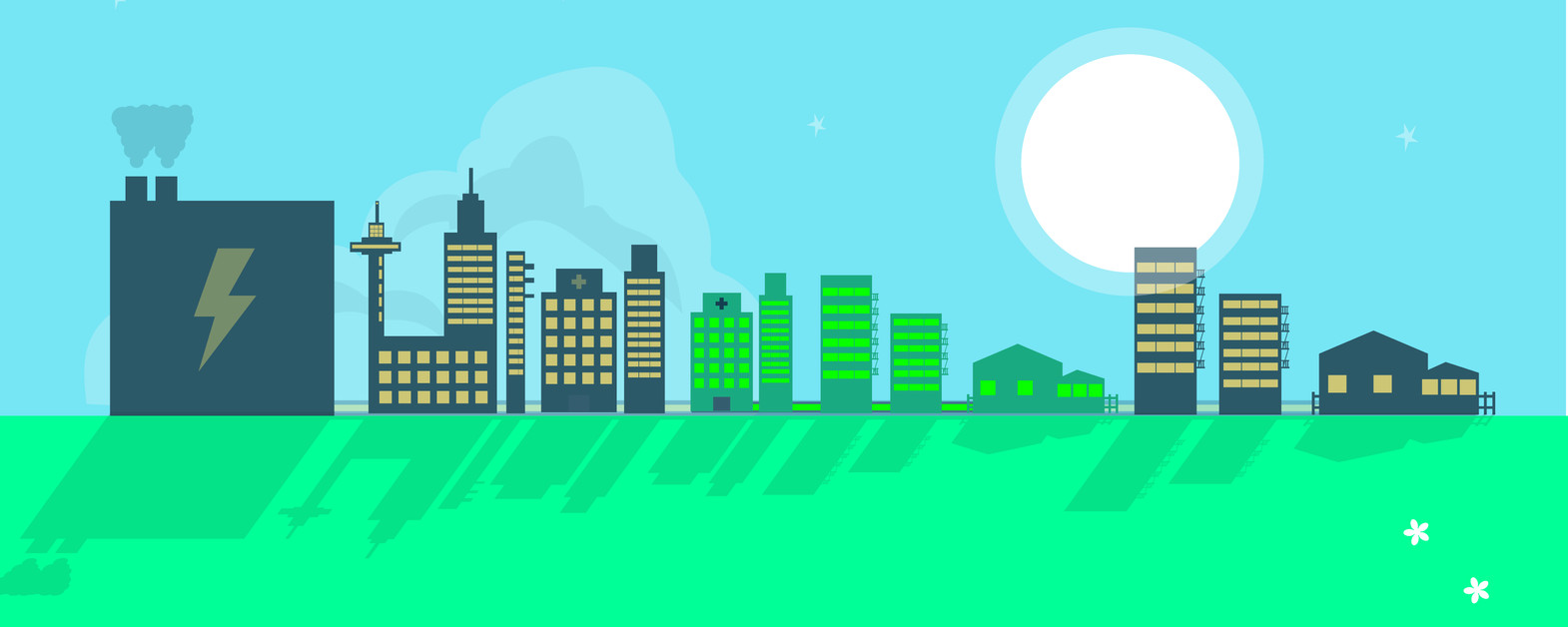
By
This is the path to a cleaner, more reliable, more resilient energy grid.
If we want a livable climate for future generations, we need to slow, stop, and reverse the rise in global temperatures. To do that, we need to stop burning fossil fuels for energy.
To do that, we need to generate lots of carbon-free electricity and get as many of our energy uses as possible (including transportation and industry) hooked up to the electricity grid. Electrify everything!
We need a greener grid. But that’s not all.
The highly digital modern world also demands a more reliable grid, capable of providing high-quality power to facilities like hospitals or data centers, where even brief brownouts can cost money or lives.
The renewable energy sources with the most potential — wind and solar — are variable, which means that they come and go on nature’s schedule, not ours. They ramp up and down with the weather, so integrating them into the grid while maintaining (and improving) reliability means finding clever ways to balance out their swings.
Finally, recent blackouts in the wake of Hurricanes Irma and Maria highlight the need for a more resilient grid — one that can get back up and running quickly (at least for essential sites) after a disaster or attack.
It’s a triple challenge: We need, all at once, a greener, more reliable, more resilient electricity grid.

But hark! Lo! There is a technology, or a set of technologies, that promises one day to be a triple solution — to address all three of the grid’s needs at once.
We speak of the humble microgrid.
What is a microgrid?
Technically, a grid is any combination of power sources, power users, wires to connect them, and some sort of control system to operate it all.
Microgrid just means a small, freestanding grid. It can consist of several buildings, one small building (sometimes called a “nanogrid”), or even one person (a “picogrid”) with a backpack solar panel, an iPhone, and some headphones.
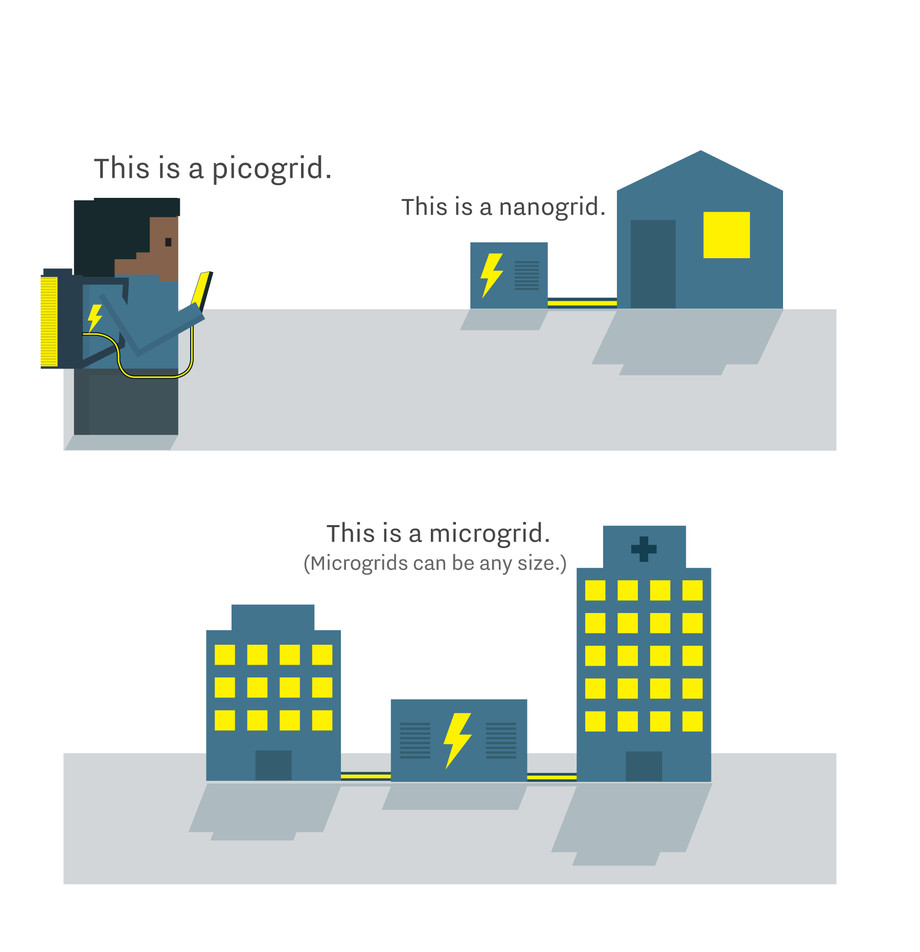
The research firm GTM counts “1,900 basic and advanced, operational and planned microgrids” in the US, with the market expected to grow quickly. Most microgrids today are basic, one-generator affairs, but more complex microgrids are popping up all over — there’s a cool one in Brooklyn, a cool one on Alcatraz Island, and the coolest one of all in Sonoma, California. Microgrids also play a big role in plans to rebuild Puerto Rico’s grid.
Let’s take a quick tour of microgrids and their potential.
Off-grid microgrids to extend power to the poor
Some microgrids stand on their own, apart from any larger grid, often in remote rural areas. These off-grid microgrids are a relatively cheap and quick way to secure some access to power for people who now lack it, often more quickly than large, centralized grids can be extended.
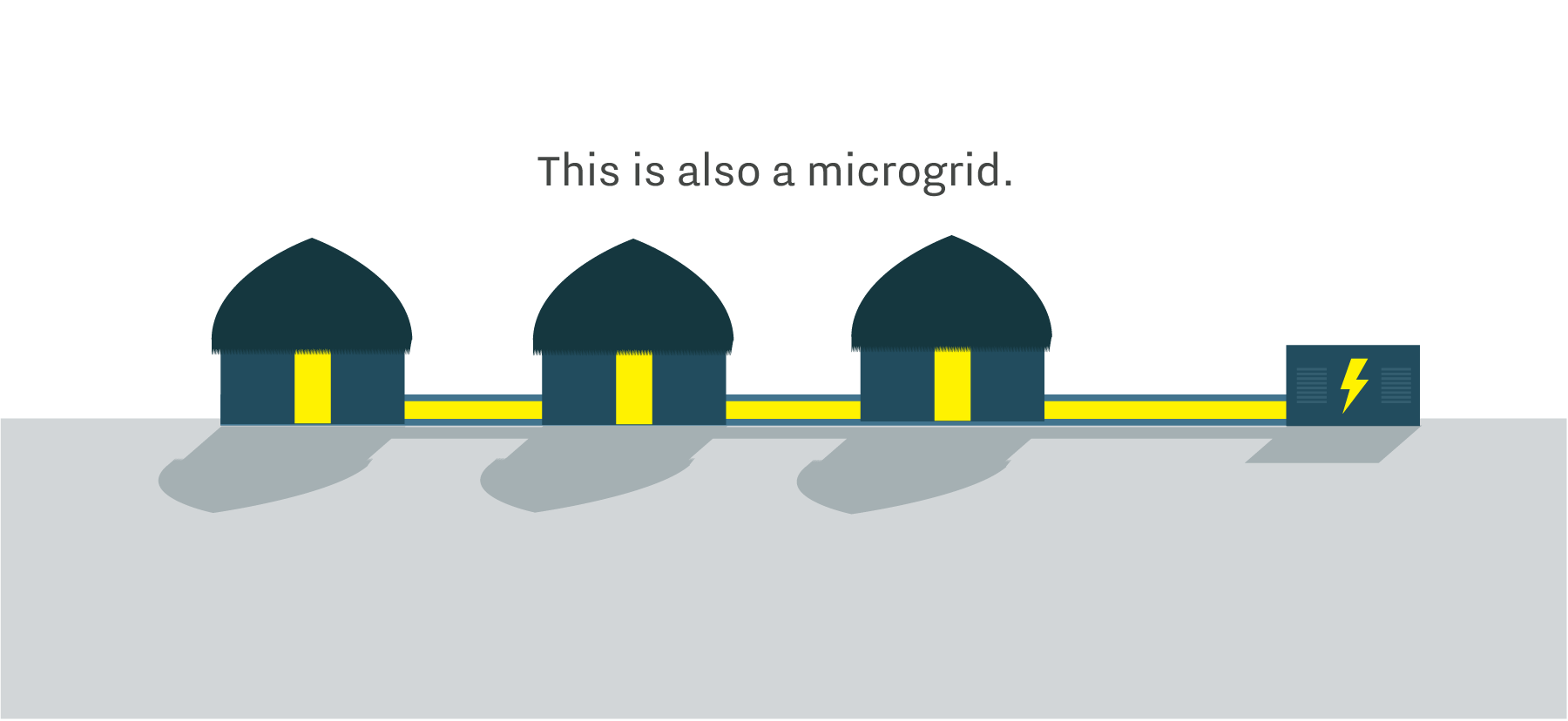
Grid-connected microgrids can “island” from the larger grid
Most microgrids, especially in wealthier nations, are grid-connected — they are embedded inside a bigger grid, like any other utility customer. All the examples cited above fit this bill.
What makes a microgrid a microgrid is that it can flip a switch (or switches) and “island” itself from its parent grid in the event of a blackout. This enables it to provide those connected to it with (at least temporary) backup power.
Again, most actually existing microgrids are extremely basic — think of a hospital with a diesel generator in the basement, or a big industrial facility with a combined-heat-and-power (CHP) facility on site that can provide some heat and power during a blackout.
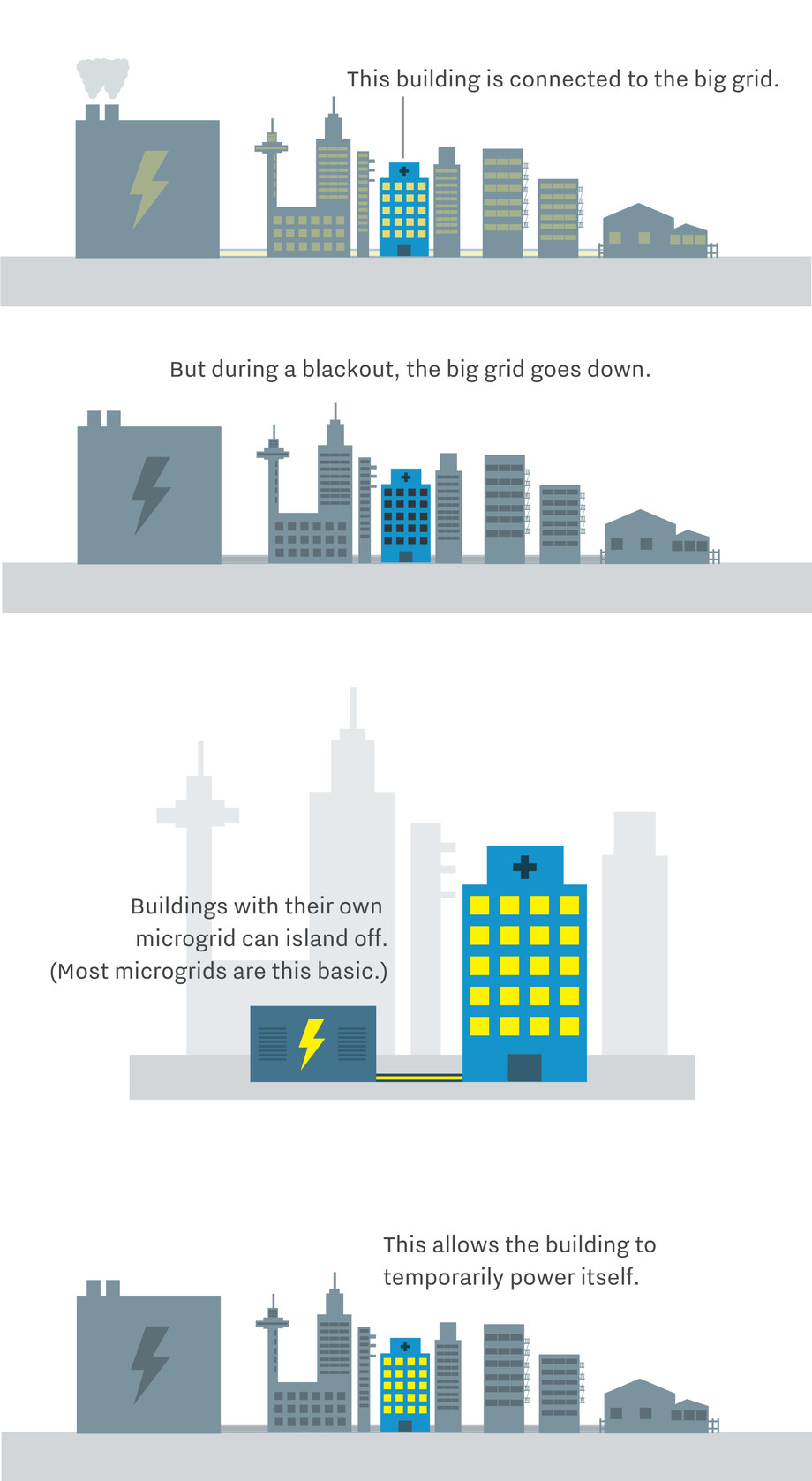
Microgrids are only at the very front edge of their potential
Microgrids won’t be a core part of the clean-energy transition until they serve all three grid needs — greener, more reliable, more resilient.
Right now, most microgrids around the world rely on diesel generators, which are polluting and loud, so they’re not very green. (In the US, the primary sources are CHP and natural gas.) They only turn on once the grid is down, so they don’t help with day-to-day reliability. Of the three grid needs, most serve only resilience, and only for those lucky enough to be connected to one.

The next step: integrating more diversity, including distributed renewable energy
As basic as most of them are today, microgrids hold great promise for the future. Technology is rapidly expanding the possibilities.
- Electricity use is becoming more controllable and adaptable, as every system and appliance learns to communicate over the internet.
- Small-scale and community-scale electricity generators are getting cheaper, cleaner, and more diverse; they now include solar panels, small-scale wind, efficient natural gas generators and fuel cells, CHP, and more. (Solar panels, in particular, have become super-cheap.)
- Energy storage is also becoming cheaper and more diverse, from various kinds of batteries and fuel cells to thermal storage in hot water or ice. (The Stone Edge Farm microgrid in Sonoma boasts five separate forms of storage.) Every bit of new storage helps to smooth out the variations in solar and wind, allowing more to be absorbed.
- Software, AI, and machine learning are enabling intelligent integration of all these diverse resources.
Smart design and software can create microgrids specifically designed to integrate distributed renewable energy, or microgrids designed to provide “six nines” (99.9999 percent) reliability, or microgrids designed for maximum resilience. There are even “nested” microgrids within microgrids.
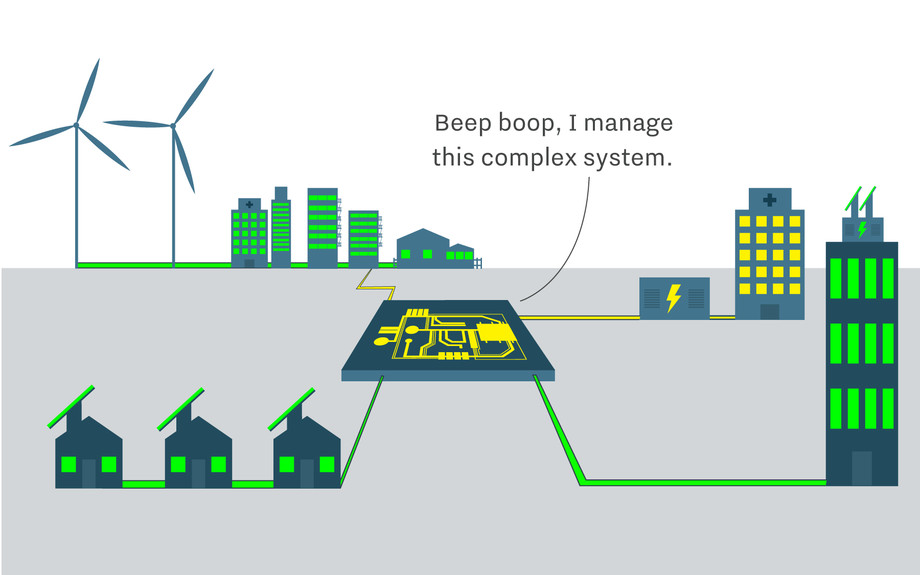
Next: microgrids need to work with the larger grid
Smarter microgrids can communicate on an ongoing basis with their parent grids, forming a beautiful friendship.
By aggregating together distributed, small-scale resources (solar panels, batteries, fuel cells, smart appliances and HVAC systems, etc.), a microgrid can present to the larger grid as a single entity — a kind of Voltron composed of distributed energy technologies.
This makes things easier on grid operators. They don’t necessarily relish the idea of communicating directly with millions (or billions) of discrete generators, buildings, and devices. It’s an overwhelming amount of data to assimilate. Microgrids can gather those smaller resources together into discrete, more manageable and predictable chunks.
Grid operators can put these chunks to good use. A smart microgrid can provide “grid services” — storing energy when it’s cheap, providing energy when it’s expensive, serving as backup capacity, or smoothing out frequency and voltage fluctuations. [*see footnote]
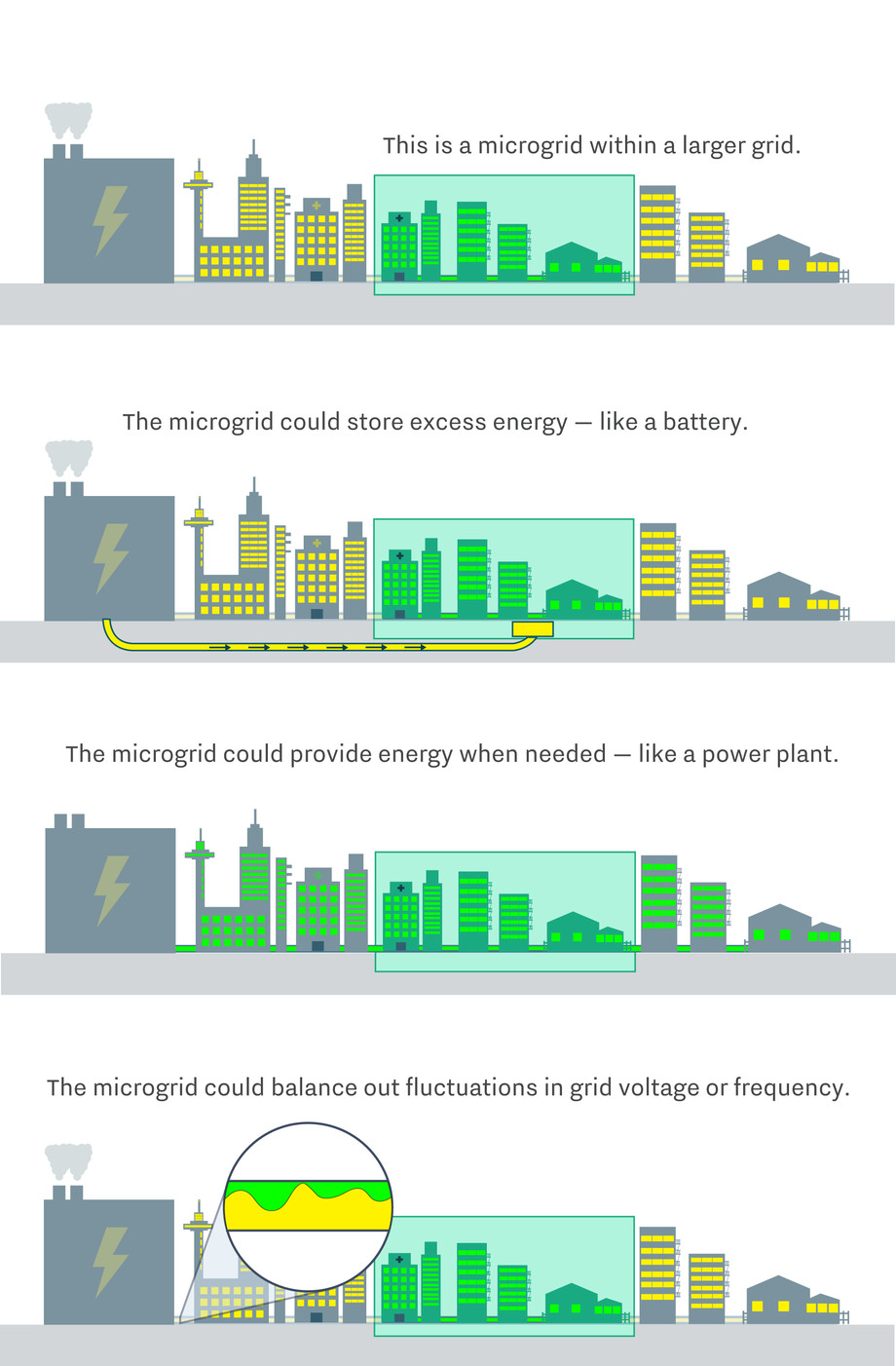
The future: a grid of microgrids
A single smart microgrid, aggregating diverse, distributed low-carbon resources, can provide cheap, clean, reliable power to those within it. It can also provide grid services to the larger grid around it.
What really tickles the imagination is a grid that contains dozens or hundreds of networked microgrids — even a grid that is someday composed of networked microgrids. This kind of “modular architecture,” with multiple semi-autonomous nodes operating in parallel, is more secure and efficient than a centralized system with a few, large points of failure.
Microgrids may never eliminate the need for large utilities, power plants, and transmission lines, but moving more power generation, management, and consumption under local control makes everyone less dependent on them.
And it makes the grid greener, more reliable, and resilient — a three’fer.
Footnote
There are other ways of aggregating small-scale distributed energy resources that do not involve a physical switch that can island them off from the grid. These “virtual” aggregations can gather together multiple small resources (batteries, solar panels, whatever) and treat the result as a single unit that participates in grid-services markets.
“Virtual power plants” offer lots of benefits, to participants and to the grid, but they do not offer the core microgrid value proposition: resilience, i.e., independence from the larger grid in times of need.
Further reading
One of us [Dave waves] will be writing more about microgrids soon. In the meantime, there are a gazillion reports floating around. A selection:
- GTM: “U.S. Microgrids 2017: Market Drivers, Analysis and Forecast”
- Institute for Local Self-Reliance: “Mighty Microgrids”
- Navigant Research: “Market Data: Microgrids” and “Military Microgrids”
- NEMA: “Powering Microgrids for the 21st-Century Electrical System”
- Alireza Aram, Energy Solutions Division, Hitachi America: “Microgrid Market in the USA”
- DOE: “The U.S. Department of Energy’s Microgrid Initiative”
